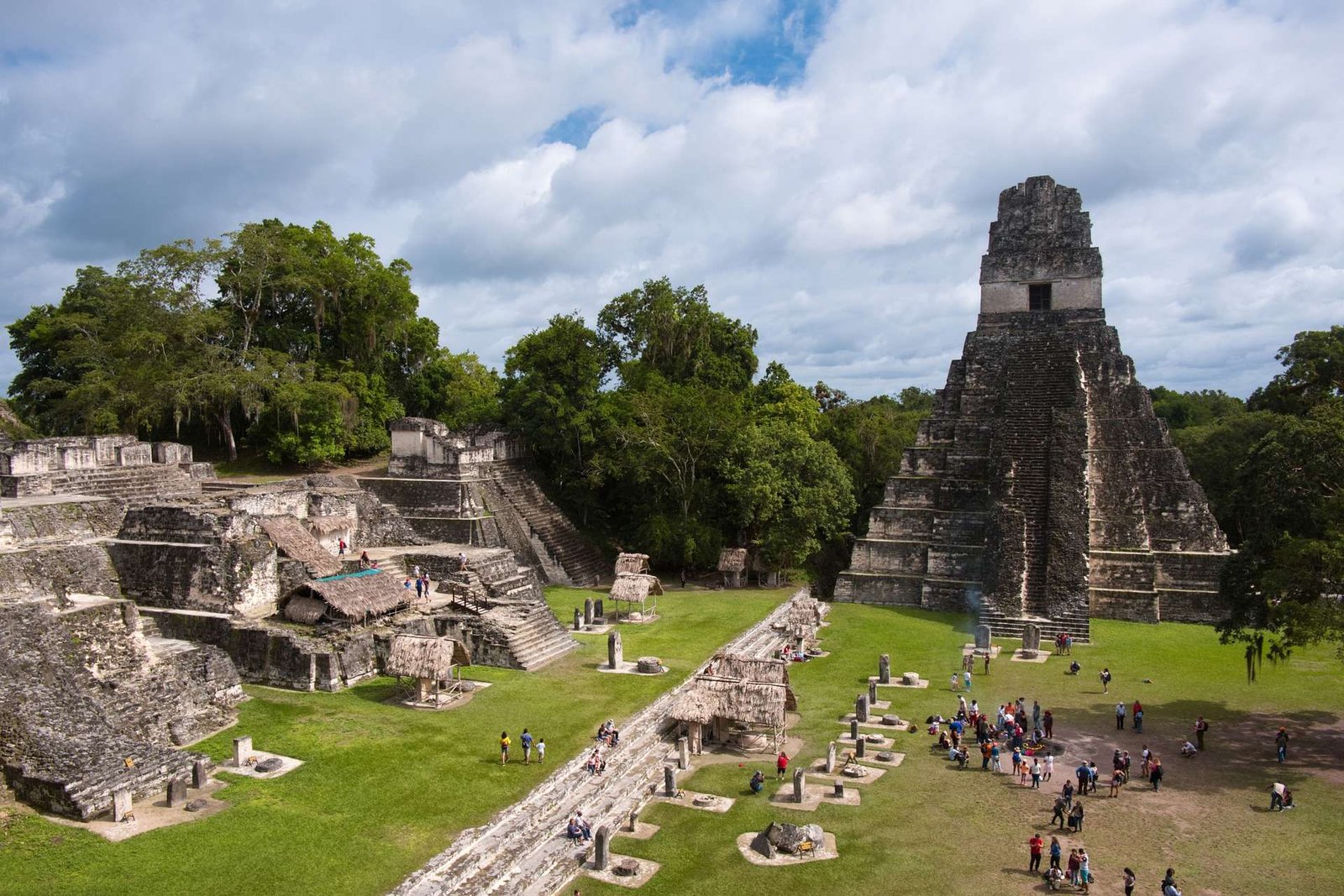Hiking and trekking adventures are a popular way to explore the world while immersing oneself in nature and challenging the body and mind. From epic long-distance trails to scenic routes through breathtaking landscapes, there are numerous destinations that offer unforgettable hiking experiences. In this article, we will unveil the top hiking and trekking destinations around the world, showcasing the best trails and highlighting the unique features of each location. Whether you are a beginner or an experienced hiker, these destinations are sure to satisfy your craving for adventure and exploration.
Key Takeaways:
- Discover the best hiking trails and trekking adventures worldwide.
- Immerse yourself in nature and challenge yourself physically and mentally.
- Explore breathtaking landscapes and unique features of each destination.
- Find the perfect hiking spot, whether you are a beginner or an experienced hiker.
- Unleash your sense of adventure and embark on an unforgettable hiking journey.
Best Hikes in the United States
The United States boasts some of the most breathtaking hiking trails in the world, offering a diverse range of landscapes and experiences for outdoor enthusiasts. Whether you’re an avid hiker looking for a challenge or a nature lover seeking scenic beauty, these trails are sure to satisfy your wanderlust. From iconic long-distance routes to hidden gems, the best hikes in the United States will take you on an unforgettable journey through the country’s stunning wilderness.
Pacific Crest Trail
Spanning over 2,600 miles from Mexico to Canada, the Pacific Crest Trail is an epic adventure that traverses through some of the most stunning landscapes in the western United States. From the deserts of Southern California to the rugged peaks of the Sierra Nevada and the Cascades, this long-distance trail offers a truly immersive experience for hikers seeking a life-changing adventure.
Appalachian Trail
The Appalachian Trail is another legendary route that spans over 2,000 miles along the eastern coast of the United States. Passing through 14 states, this trail offers hikers a chance to explore diverse ecosystems, charming small towns, and challenging terrains. Completing the entire trail is a bucket list achievement for many outdoor enthusiasts.
Three Ridges Wilderness
If you’re looking for a challenging hike with stunning panoramic views, the Three Ridges Wilderness in Virginia is a must-visit destination. This 13-mile loop trail takes hikers through rugged terrain, rocky ridges, and dense forests, rewarding them with breathtaking vistas of the Virginia Blue Ridge Mountains.
Grand Canyon Rim to Rim
The Grand Canyon Rim to Rim hike is a once-in-a-lifetime experience that allows hikers to explore the awe-inspiring beauty of one of the world’s natural wonders. This strenuous trek takes you from the North Rim to the South Rim, offering unparalleled views of the iconic canyon and immersing you in its geological splendor.
Enchantments Alpine Lakes
Located in Washington’s Cascade Mountains, the Enchantments Alpine Lakes is a magical hiking destination that showcases pristine alpine lakes, jagged peaks, and enchanting meadows. This challenging hike requires a permit and is known for its breathtaking beauty and dramatic landscapes that resemble scenes from a fairytale.
Kalalau Trail
Hawaii’s Kalalau Trail is a mesmerizing coastal hike that takes you along the rugged cliffs of the Na Pali Coast on the island of Kauai. This challenging 11-mile trek rewards hikers with stunning views of cascading waterfalls, turquoise waters, and lush green valleys, making it an unforgettable bucket list experience.
These are just a few examples of the best hikes in the United States. Each trail offers its own unique charm, challenges, and natural wonders. Lace up your hiking boots and explore the beauty of America’s breathtaking landscapes.
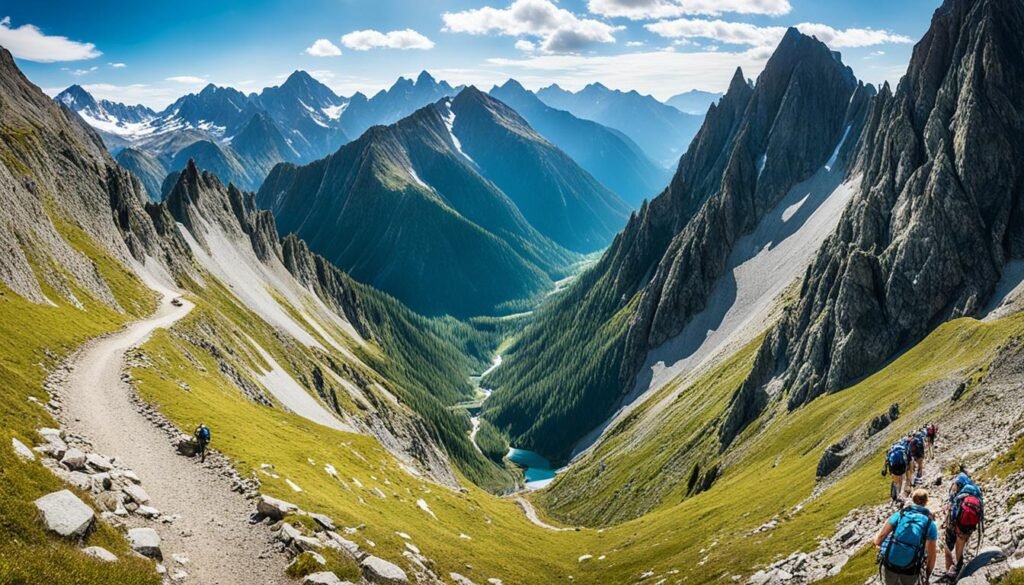
| Trail | Location | Distance | Difficulty |
|---|---|---|---|
| Pacific Crest Trail | Mexico to Canada | 2,600 miles | Challenging |
| Appalachian Trail | Eastern United States | 2,190 miles | Strenuous |
| Three Ridges Wilderness | Virginia | 13 miles | Moderate to Difficult |
| Grand Canyon Rim to Rim | Arizona | 21 miles | Strenuous |
| Enchantments Alpine Lakes | Washington | 18 miles | Demanding |
| Kalalau Trail | Kauai, Hawaii | 11 miles | Challenging |
Epic Hiking Trails Around the World
Beyond the United States, there are countless other hiking destinations around the world that offer breathtaking landscapes and unforgettable adventures. From the Great Ocean Walk in Australia, which takes hikers along the stunning Australian coast, to the Kungsleden trail in Sweden, known for its remote and otherworldly landscapes, and the Wales Coast Path in the UK, which offers a unique combination of rugged coastline and ancient castles, these trails showcase the beauty and diversity of our planet.

Other notable hikes include the Jordan Trail in Jordan, the Gotemba Trail in Japan with its iconic Mt. Fuji, and the Waitukubuli National Trail in Dominica, offering a tropical rainforest experience. These hiking trails are renowned for their natural beauty and cultural experiences, making them must-visit destinations for adventure seekers.
Top-Rated Hiking Trails Worldwide
| Hiking Trail | Location |
|---|---|
| Great Ocean Walk | Australia |
| Kungsleden trail | Sweden |
| Wales Coast Path | United Kingdom |
| Jordan Trail | Jordan |
| Gotemba Trail | Japan |
| Waitukubuli National Trail | Dominica |
These trails offer a variety of experiences, from coastal walks to mountain treks and everything in between. Whether you’re seeking panoramic views, unique landscapes, or cultural immersion, these hiking destinations have it all. Lace up your boots and embark on the ultimate trekking adventures around the world.
Mental Health Benefits of Hiking
Hiking is not just a physical activity; it also has numerous mental health benefits. Research has shown that spending time in nature and engaging in outdoor activities like hiking can reduce stress, improve mood, enhance mindfulness, and boost overall mental well-being.
The combination of physical exertion and immersion in nature creates a sense of calm and relaxation, allowing hikers to disconnect from the pressures of daily life and find inner peace. The rhythmic motion of walking and the gentle sounds of nature can be meditative, promoting a state of mindfulness and helping to alleviate worries and anxieties.
Hiking also provides an opportunity for solitude and self-reflection. Being away from the noise and distractions of modern life allows hikers to tune in to their thoughts and emotions, fostering mental clarity and personal growth. It offers a break from the constant stimulation of screens and technology, allowing hikers to reconnect with themselves and the natural world around them.
The mental health benefits of hiking extend beyond the immediate activity itself. Spending time in nature has been linked to improved cognitive function, increased creativity, and reduced symptoms of depression and anxiety. The beauty of the natural environment can inspire awe and a sense of wonder, which in turn leads to greater life satisfaction and overall happiness.
Incorporating hiking into your routine can provide a powerful boost to your mental well-being. Whether it’s a short hike on a local trail or a challenging trek through rugged terrain, the act of immersing yourself in nature and engaging in physical activity offers a holistic approach to nurturing both the body and the mind.
So why not take advantage of the mental health benefits of hiking and embark on your next outdoor adventure? Lace up your boots, breathe in the fresh air, and let the beauty of nature rejuvenate your spirit.

Planning and Preparation for a Hiking Adventure
Before embarking on a thrilling hiking adventure, proper planning and preparation are key to ensuring a safe and enjoyable experience. Taking the time to research the trail, understand its difficulty level, and assess your own fitness and experience will help you make informed decisions and set realistic goals for your hike.
Gear and Equipment
Equipping yourself with the essential hiking gear is vital to tackle the challenges of the trail. Here are some items that should be on your packing list:
- Sturdy Hiking Boots: Choose a comfortable pair of hiking boots that provide ankle support and have a good grip for different terrains.
- Layers of Clothing: Dress in layers to adapt to changing weather conditions. Pack moisture-wicking base layers, insulating mid-layers, and a waterproof and wind-resistant outer layer.
- Backpack: Carry a backpack that fits well, distributes weight evenly, and has enough capacity to carry your gear and supplies.
- Map and Compass or GPS: Bring a map and compass or a GPS device to navigate the trail and stay on course.
- Water and Snacks: Stay hydrated by carrying enough water and pack energy-boosting snacks to fuel your hike.
- First Aid Kit: Be prepared for minor injuries with a well-stocked first aid kit that includes bandages, antiseptic wipes, pain relievers, and any personal medications.
Remember, the right gear can make a significant difference in your comfort and safety on the trail.
Hiking Safety Tips
Prioritizing safety is crucial when venturing into the great outdoors. Here are some important hiking safety tips to keep in mind:
- Inform Others: Let someone know about your hiking plans, including your itinerary and expected return time.
- Weather Awareness: Check the weather forecast before your hike and be prepared for changing conditions. Postpone your hike if severe weather is expected.
- Stay on Designated Trails: Stick to marked trails and avoid venturing into unknown areas to minimize the risk of getting lost or encountering dangerous terrain.
- Wildlife and Hazards: Be mindful of wildlife, such as bears or snakes, and know how to react if you encounter them. Stay away from cliff edges and unstable terrain.
By following these safety tips and using common sense, you can significantly reduce the risks associated with hiking.
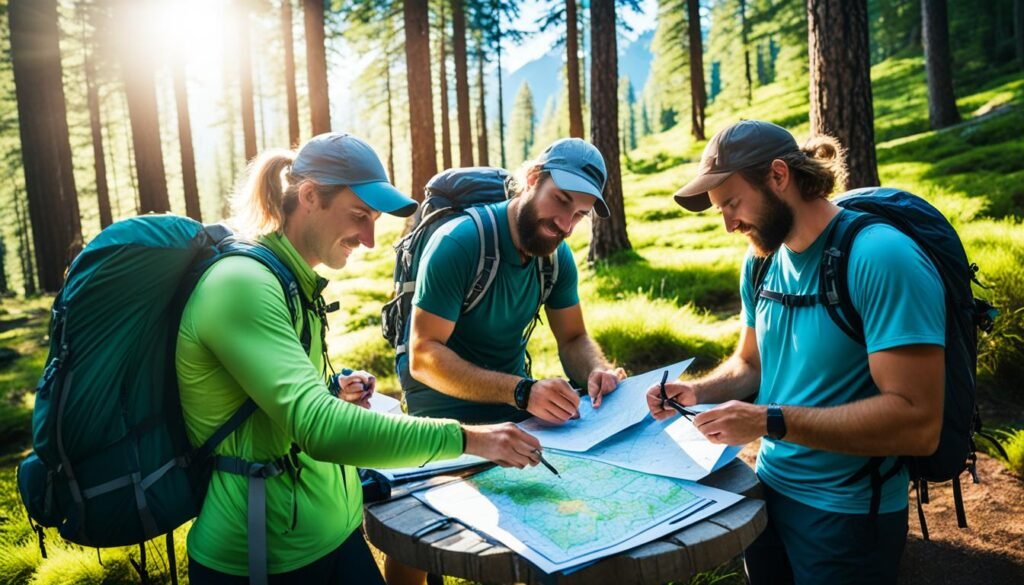
Being well-prepared is essential for a successful hiking adventure. Take the time to plan your trip, pack the necessary gear, and prioritize safety. With proper preparation, you can embark on your hiking journey with confidence, knowing that you’re ready for whatever the trail may bring.
| Planning and Preparation Checklist |
|---|
| Research the trail and understand its difficulty level |
| Assess your fitness and hiking experience |
| Pack sturdy hiking boots, layers of clothing, a backpack, a map and compass or GPS device, water and snacks, and a first aid kit |
| Inform someone about your hiking plans |
| Check the weather forecast and be prepared for changing conditions |
| Stay on designated trails and avoid unknown areas |
| Be aware of wildlife and potential hazards |
Notable Multi-day Hiking Adventures
For those seeking an immersive and challenging hiking experience, multi-day hiking trips are the ultimate adventure. These long-distance trails often require several days and nights of camping or staying in designated shelters or lodges along the way. Examples of notable multi-day hiking adventures include the Pacific Crest Trail in the US, the O Circuit in Torres del Paine National Park in Chile, and the Jordan Trail in Jordan. These expeditions offer a unique opportunity to truly immerse oneself in nature, disconnect from the outside world, and test physical and mental limits. They are extraordinary adventures that provide a deep sense of accomplishment and awe-inspiring landscapes.
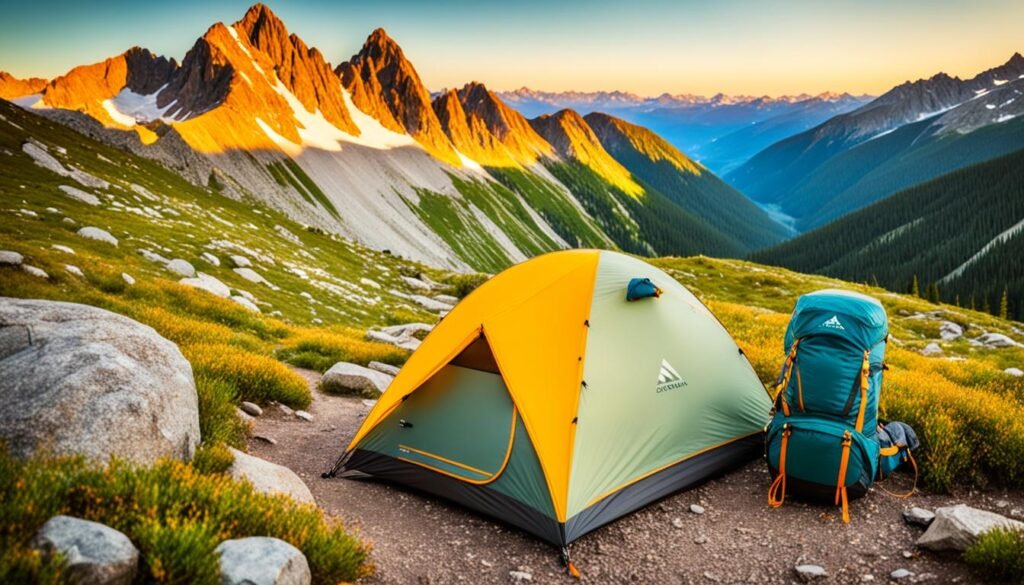
Notable Multi-day Hiking Adventures:
- Pacific Crest Trail (US)
- O Circuit (Torres del Paine National Park, Chile)
- Jordan Trail (Jordan)
Embarking on a multi-day hiking adventure is a transformative experience that allows you to fully immerse yourself in nature and push your physical and mental limits. Whether you choose to tackle the scenic trails in the US, the breathtaking landscapes of Torres del Paine National Park in Chile, or the cultural and natural wonders along the Jordan Trail, these expeditions promise to deliver a sense of accomplishment and awe. Each of these long-distance hiking trails offers its own unique challenges and rewards, making them the epitome of epic hiking expeditions.
Hiking for Fitness and Well-being
Hiking is not only an enjoyable outdoor activity but also a great way to stay fit and improve overall health. It is a low-impact exercise that engages various muscle groups, strengthens the cardiovascular system, and improves endurance and flexibility. Hiking also provides a natural and scenic environment that can enhance the overall workout experience compared to indoor workouts.
In addition to the physical benefits, hiking has been shown to have positive effects on mental well-being, providing a sense of calm, mindfulness, and overall happiness. Being in nature has a unique way of reducing stress levels and promoting relaxation. The combination of fresh air, picturesque views, and the rhythm of walking can have a soothing effect on the mind.
“Hiking is the perfect combination of exercise and nature’s therapy. It allows you to challenge your body while providing ample opportunities for relaxation and connection with the environment.”
Whether you’re a beginner or an experienced hiker, incorporating hiking into your fitness routine can contribute to a healthier lifestyle. The varying terrains and difficulty levels of hiking trails offer a range of options that can be customized to suit individual fitness levels and goals. The best part is that hiking doesn’t feel like a monotonous workout – it’s an adventure where every step takes you closer to stunning landscapes and new discoveries.
Health Benefits of Hiking
Hiking offers numerous health benefits. Here are some of the key advantages:
| Health Benefits | Description |
|---|---|
| Improved Cardiovascular Fitness | Hiking helps strengthen your heart, improves blood circulation, and lowers the risk of heart diseases. |
| Weight Management | Hiking is an effective way to burn calories and maintain a healthy weight. |
| Enhanced Muscle Strength and Tone | Hiking engages your leg muscles, core, and upper body, resulting in improved strength and muscle tone. |
| Increased Bone Density | The weight-bearing nature of hiking helps promote bone health and reduces the risk of osteoporosis. |
| Stress Reduction | Spending time in nature and engaging in physical activity can lower stress levels and promote relaxation. |
| Mental Well-being | Hiking in nature has been linked to improved mood, reduced anxiety, and increased feelings of overall happiness and well-being. |
So put on your hiking boots, pack your essentials, and embark on a journey that not only improves your fitness but also enriches your soul. Experience the joy of hiking and discover the incredible health benefits it has to offer.
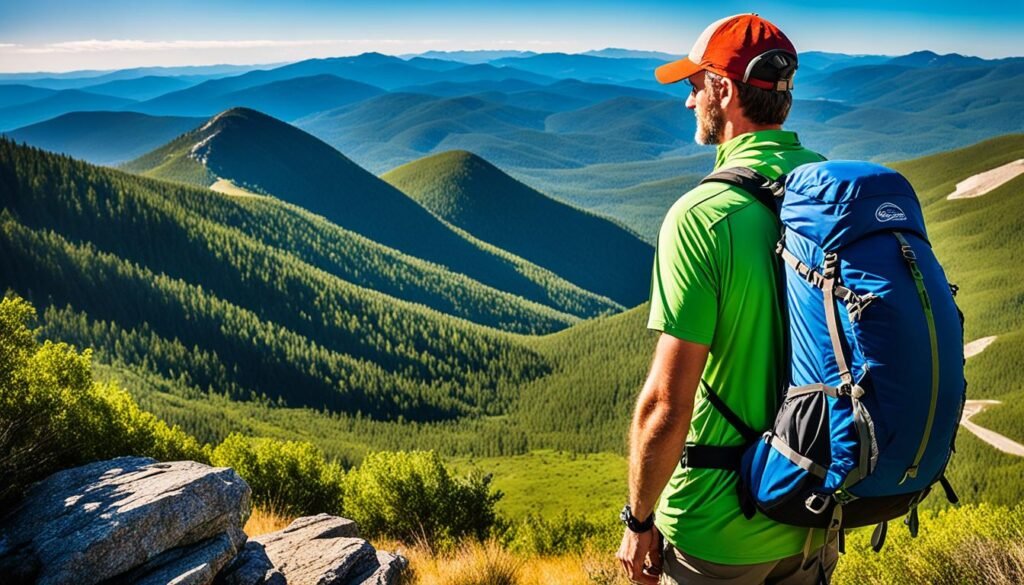
Safety Considerations for Hiking Adventures
While embarking on a hiking adventure can be thrilling, it’s essential to prioritize safety to ensure a positive and secure experience. By being aware of potential risks and hazards, staying informed about weather conditions, and taking necessary precautions, hikers can minimize risks and increase their preparedness in the wilderness.
Hiking Safety Guidelines
Follow these hiking safety guidelines to ensure a safe and enjoyable outdoor experience:
- Research the trail and assess its difficulty level before starting your hike.
- Inform someone about your hiking plan, including your intended route and estimated return time.
- Stay on designated trails and avoid venturing off into unmarked areas.
- Be aware of your surroundings and watch out for potential hazards, such as loose rocks or steep drops.
- Closely monitor weather forecasts and avoid hiking during severe weather conditions.
- Carry essential safety equipment, including a first aid kit, flashlight, map, compass or GPS device, whistle, and extra food and water.
- Dress appropriately for the weather and wear sturdy hiking boots to protect your feet.
- Stay hydrated by drinking plenty of water throughout your hike.
- Be cautious of wildlife encounters and maintain a safe distance.
- Use common sense and trust your instincts. If a situation feels unsafe, remove yourself from it.
Emergency Preparedness
Even with proper precautions, emergencies can still occur while hiking. It’s crucial to be prepared for unforeseen situations:
“In case of emergencies, having a communication device, such as a cell phone, and knowing how to navigate and seek assistance can be life-saving.”
Here are some emergency preparedness tips:
- Carry a fully charged cell phone with emergency numbers saved and ensure you have signal coverage.
- Learn basic first aid techniques and pack a comprehensive first aid kit.
- Familiarize yourself with the trail map and carry a compass or GPS device for navigation.
- Inform yourself about the nearest emergency services available in the area.
- Consider taking a wilderness first aid or survival skills course to enhance your knowledge and preparedness.
| Hiking Safety Tips | Emergency Preparedness Tips |
|---|---|
| Research the trail and assess its difficulty level. | Carry a fully charged cell phone. |
| Inform someone about your hiking plan. | Learn basic first aid techniques. |
| Stay on designated trails. | Familiarize yourself with the trail map and carry a compass or GPS device. |
| Be aware of your surroundings and potential hazards. | Inform yourself about the nearest emergency services available. |
| Closely monitor weather forecasts. | Consider taking a wilderness first aid or survival skills course. |
| Carry essential safety equipment. | |
| Dress appropriately and wear sturdy hiking boots. | |
| Stay hydrated. | |
| Be cautious of wildlife encounters. | |
| Use common sense and trust your instincts. |
Wilderness Safety Tips
When venturing into the wilderness, keep these additional safety tips in mind:
- Learn about the local wildlife and know how to react if you encounter wild animals.
- Leave no trace by practicing proper waste disposal and minimizing your impact on the environment.
- Be mindful of natural hazards, such as streams or rivers with a strong current.
- Respect wildlife habitats and refrain from disturbing the natural ecosystem.
- Stay informed about any local regulations or restrictions applicable to the hiking area.
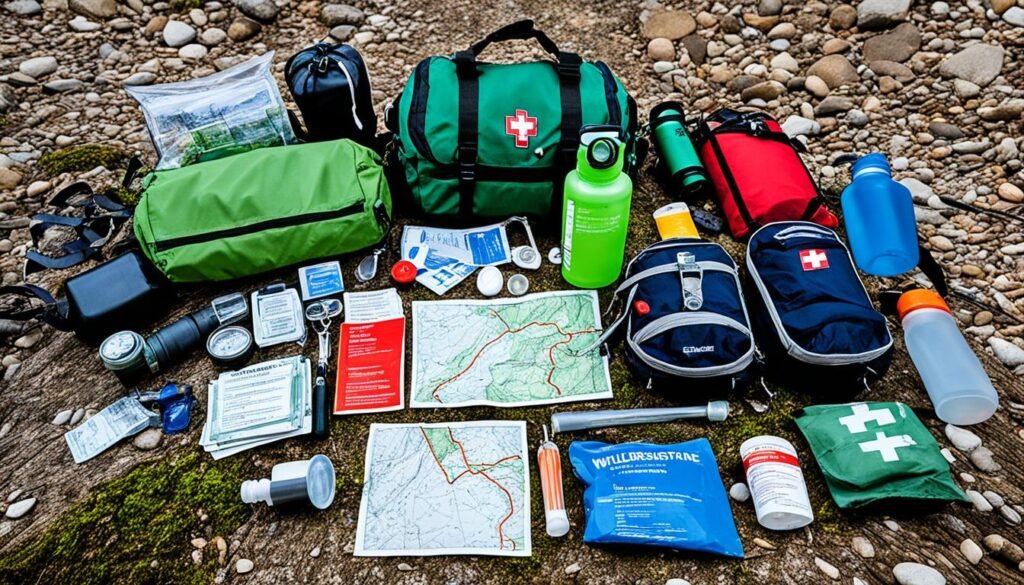
By prioritizing safety and being prepared, hikers can fully enjoy the beauty and adventure of hiking while minimizing risks. Remember, the key to a successful hiking adventure lies in your preparation, knowledge, and common sense.
Conclusion
Hiking and trekking adventures provide the perfect opportunity to discover the world, challenge yourself, and immerse in the beauty of nature. Whether you’re exploring the breathtaking landscapes of the United States, venturing into remote trails in Sweden, or experiencing the cultural richness of different countries, there is a hiking destination tailored for every enthusiast.
In addition to the physical benefits, hiking has a profound impact on mental well-being. The serene surroundings, the solitude, and the physical exertion of hiking induce a sense of calm, mindfulness, and overall happiness. It’s a chance to disconnect from the pressures of daily life, find inner peace, and rejuvenate the mind and soul.
To fully enjoy the rewards of hiking, it’s essential to plan and prepare for your adventure. Prioritizing safety, packing the right gear, and being aware of your fitness level and the difficulty of the trail are crucial steps. By incorporating hiking into your fitness routine, you can harness the countless benefits this exhilarating activity offers.
So, lace up your boots, embrace the adventure, and embark on an unforgettable hiking journey. Whether you’re seeking the best destinations for hiking and trekking, looking to improve your mental well-being, or planning a hiking trip, the world is waiting for you to explore its trails and wonders.

